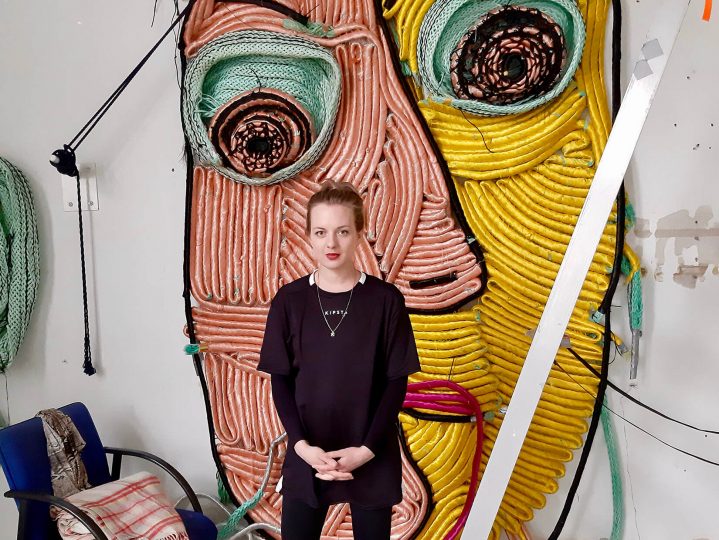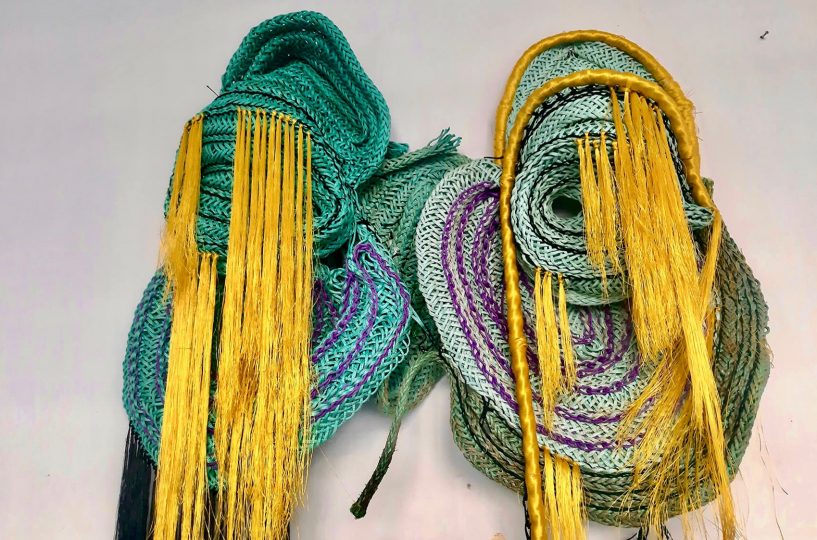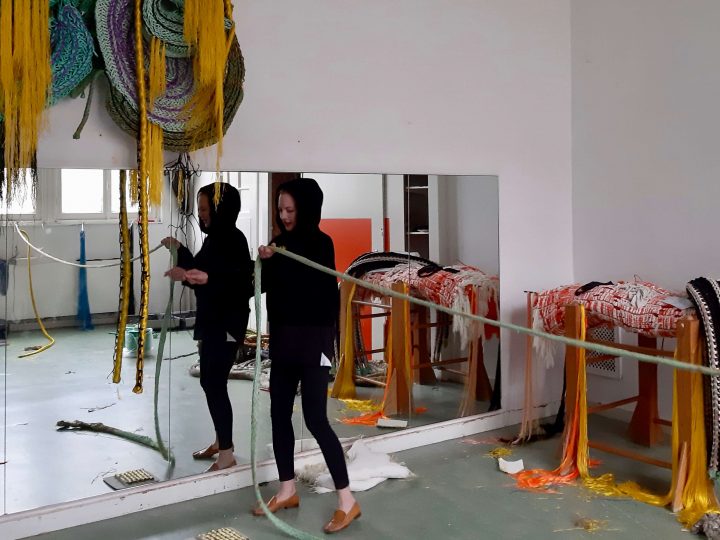Joana Schneider (1990) is an emerging talent in the art world. In 2018 she graduated from the Textile department at the Royal Academy of the Arts, The Hague. She is already known for her large-scale installations that exceed the human dimension, transforming space mainly using recycled materials. Recently she installed her signature work ‘PLUIS’ for a private commission and as a permanent installation in a meeting room of the new Arttenders’ office. Arttenders went to visit her studio, a chaos of yarns and colors. We spoke about fashion, visual storytelling, sustainability and environmental consciousness, suddenly becoming an artist and of course… ‘PLUIS’.

Joana Schneider in her studio in the Hague
Your name is becoming well known in the art scene, but who is Joanna Schneider?
Maybe there is an anecdote I can tell. When I moved to Den Haag I wanted to study fashion but then I switched to textile design. Still, it never worked out for me! I remember I was getting criticisms because my work was very wild, each print was always coming out different. I think this is also often the difference between artists and designers: they find peace in making something very organized and my brain can’t function like that! It’s often not helpful but this also allows me to make combinations and switch.
Despite your original interest in fashion and your background in textile currently you are working full-time as a visual artist. How has this happened?!
I never intended to become an artist. I went to the Royal Academy of the Arts (KABK) to study fashion, although later I specialized in textile. When I started I wasn’t even aware that this department existed! I studied both fashion design and textile for the first half-year. When they asked me: “Which directions are you going to chose?” I decided very spontaneously on the spot, literally on the stage in front of everyone.
“I don’t chose everything very consciously, most times I just let it happen”
At the KABK you can become whatever you want, they are really good at helping you to understand where your strengths lie. A big influence on my approach to my work was the annual exhibition at the electricity factory. This huge industrial place requires the creation of something very present, either in colors or scale. It’s so dark and dusty that a work too small or not very physical risks to get lost.
In the second year I made a sound installation with microphones and laser cut foam. It was my first autonomous work although it didn’t have many design aspects in it. From then I started scaling up every year really placing the focus on the audience. I wanted to have a very good annual show, plus I had this idea in the back of my mind already. My work was just getting bigger and bigger. I think this also influenced how later I started working and looking at projects.
“I started scaling up every year really focusing on the audience.”

During the course of the years my work started growing in size, becoming more art than textile design. I just loved to make big works and big installations. People started calling me an artist, even though I never chose to be one consciously. This is a bit how my works are shaped as well: it just happens through a combination of external circumstances and intuition.
“I wouldn’t feel comfortable using a material that I know leaves a negative impact. There are so many solutions, one just has to be smart about it.”

Anything concerning sustainability has gained much attention becoming a hot topic for everyone. Environmental awareness is also key to your art. Is there a specific reason behind your focus on it?
All the materials I work with come from the sea and the fishing industry, where sustainability is a huge problem. In general though I believe my awareness comes from my education and my background. If sustainability is a big topic in the art world, it’s even bigger in the textile industry. With any yarn you question whether is it ethical to use it, where it comes from and how it can be recycled afterwards.
“The contradiction between the name, the fact that looks so pretty and at the same time it is so bad, I found it intriguing”
How did you meet pluis, the material on which your artworks are based?
When I saw it the first time on a boat I though it was a festive decoration for a party. I asked what was it for and a fisherman explained me that pluis is the buffer zone between the ocean and the nets on which it is knotted as a protection. The problem is that after two weeks it wears off into the ocean and needs to be replaced. For this reason it becomes very bad for the environment. The word actually means ‘fluff’, such a cute name for a wasteful material! The contradiction between the name, the fact that looks so pretty and that at the same time it is so bad, I found it intriguing. I wanted to work with it, with that technique and aesthetic.

Why have you chosen to work only with postconsumer yarns and recollected materials?
Initially I was working with the real pluis, made of polypropylene. It is difficult to reuse though, because it gets lost in the ocean. Collecting it would be a really great project but it would be half of the job too. I started working with different companies who produce yarns with plastic from the ocean, but their supplies where not very suitable for my works. For this reason I now employ yarns recycled from any kind of plastic. Sometimes even using it as a material is not as bad as it might sound: unlike other materials, many plastics can be processed into their original state and be reused.
“I try to avoid that it has big influence on the outcome: it’s more about the aesthetic that comes from it”
The fist time I saw the neon green yarn I got mind blown! It was so beautiful, especially because how it is produced in a totally sustainable way. I immediately knew I wanted to use it. For my graduation project. I contacted the producer, Morssinkhof Rymoplast. They ended up sponsoring the material. When they delivered kilos of yarns at my school I was just so grateful. It was amazing!

With everyone talking about sustainability it can be hard to convey a strong message and the risk to sound repetitive is high. What makes your work different?
Even though sustainability is a topic I am constantly busy with in each design and artistic process, I don’t want to be didactic. It’s my personal choice to be aware, but creating awareness is not my goal: people don’t have to think about sustainability when looking at my work. The influence lies more in the aesthetic that comes from recycled ropes and postconsumer yarns. I’m happy when people appreciate it as an added value, but I try not to make my art only about sustainability issues. The story I want to share with my creations is that sustainability means a lot to me, but as much as techniques and scale do.
“I want people to have an experience.”
How do you try to communicate with people through your works?
I get a lot of inspiration from theatre because I consider my installations as costumes for spaces where people can have an experience. I think this works quite well with the installation of PLUIS at the Arttenders’ office: there you really enter it. Actually I was doubtful whether the small space was optimal for the big scale of the work. The end result though was exactly what I like my work to do. You don’t just perceive an image, there you really enter it! In this particular case PLUIS is almost like sound: you can’t escape it. Sometimes I wonder how it actually affects the meetings in the office.
“I take direct inspiration from the craft of fisherman, translating their practices in my art”

Before creating PLUIS you went to learn how to web the nets in a fisherman’s village. Can you tell us a bit about the craft behind its realization?
I went to a fisherman’s village to take detailed pictures of webs and shoot videos, that’s how my research started. This knowledge allowed me to think how I could use this techniques in my works. I love that these men have so many practical solutions for things I am constantly busy with! How could I do their same attachments and combine them with simple textile techniques?
“I genuinely love when aesthetic comes from labor but I know what they do has also an immediate negative impact. Art is where I try to combine all these contrasts”
I always de- and re-contextualize the materials and techniques to find the perfect fit with my art. Even if sometimes it is a very simple way of working, the translation is not always immediate. It can be a very long thinking process, but it’s always intriguing to see how the surfaces change after every particular knot.
How did the idea of going there to learn these techniques came about?
My passion for the ocean comes from the simple fact that I didn’t grow up close to it. Before coming to Den Haag going to the sea was a very rare occasion, making it a very special place for me. I am also very fascinated by manly crafts, even if masculinity and textile could sound contradictory. I think me going to the ocean and the harbor came after this fascination with the ocean and the people related to it. Even how ships are built is just fantastic: there is so much structure and intelligence in their shape. I really love the aesthetic in that.
I have a sort of paradoxical relationship with the people in the harbor: I genuinely love when aesthetic comes from labor but I know what they do has also an immediate negative impact. Art is where I try to combine all these contrasts. It doesn’t matter which material I am using, I always try to figure out a sustainable solution.
Everything Joana does is inspired by her fascination with labour and craft. With her unique approach she upcycles waste and sustainable materials into monumental designs that are impossible to escape. We love how she transforms the environment engaging viewers in unique colorful experiences! With her story and a talent she is definitely a great artist to keep an eye on.

Even though sustainable storytelling is not the primary goal of Joana’s works, PLUIS is an exemplary work that functions as a perfect conversation piece in the Arttenders office! Also challenged with raising awareness on sustainability, resilience, energy transition or other complex themes? Don’t hesitate to reach out to us.

